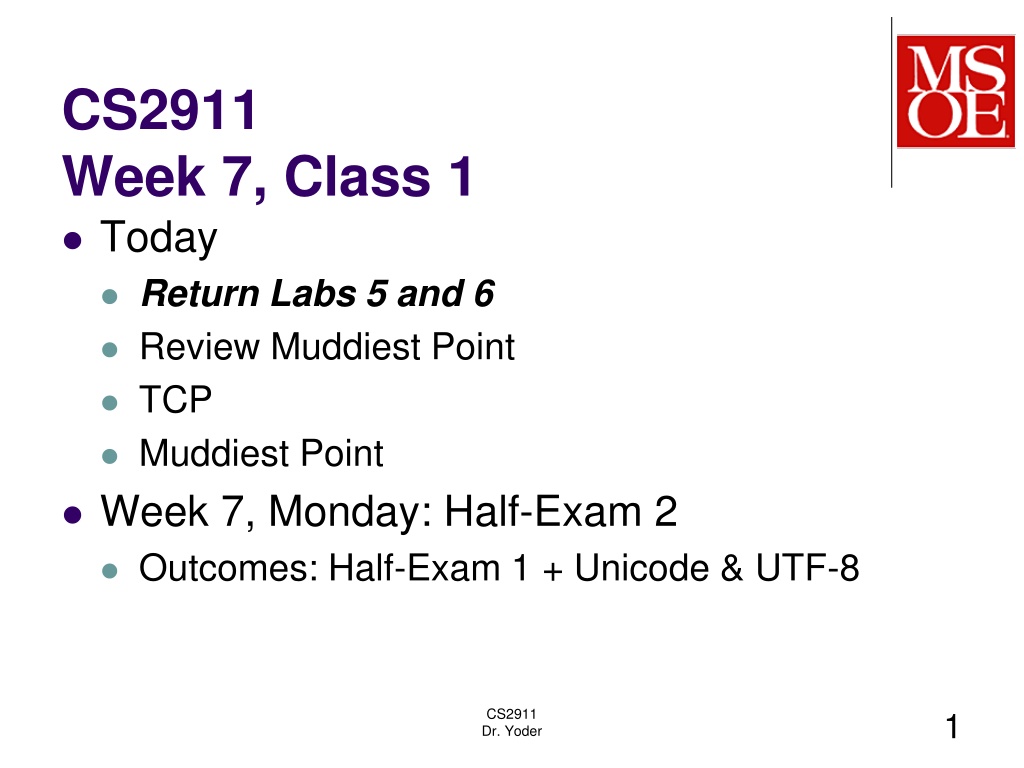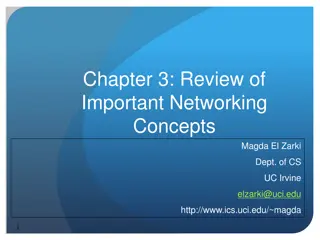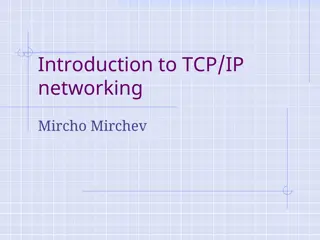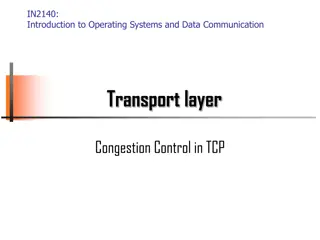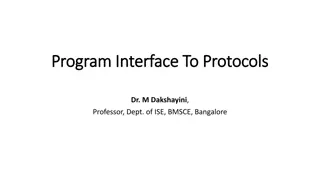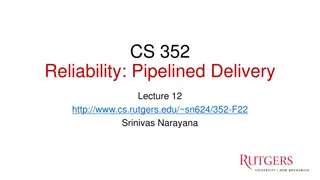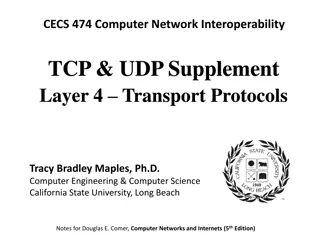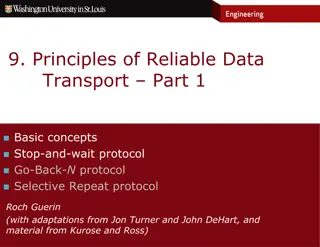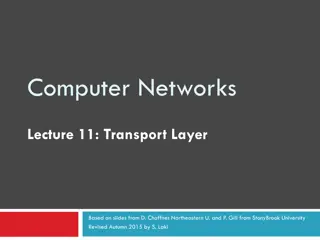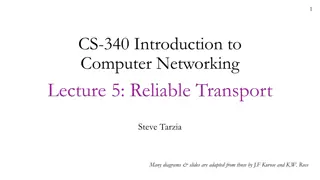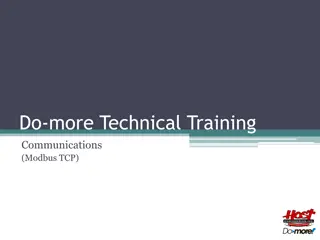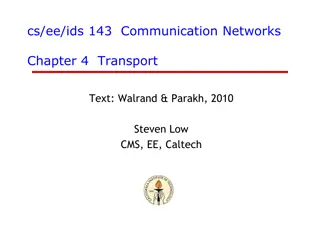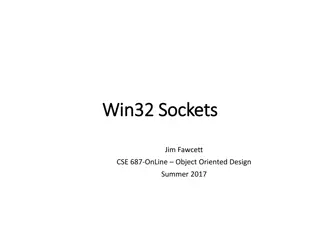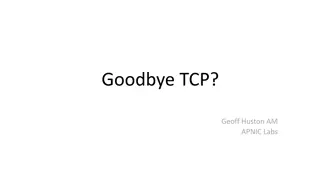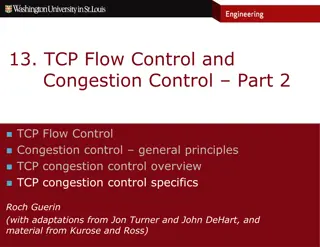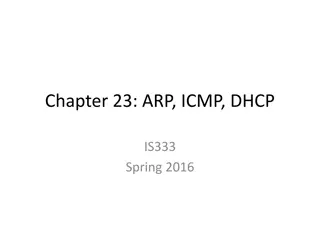Understanding TCP Protocol and Reliability in Networking
This content covers key concepts related to the TCP protocol in networking, including TCP header fields, sequence and acknowledgement numbers, the 3-way handshake, and reliability mechanisms such as error detection, feedback, and retransmission. It also discusses potential issues in TCP communication like lost, corrupted, reordered, and malicious packets, as well as solutions to ensure reliable data transmission. Additionally, it explores aspects like Stop-and-Wait protocol, packet loss, sliding window technique, and round-trip time (RTT).
Download Presentation

Please find below an Image/Link to download the presentation.
The content on the website is provided AS IS for your information and personal use only. It may not be sold, licensed, or shared on other websites without obtaining consent from the author. Download presentation by click this link. If you encounter any issues during the download, it is possible that the publisher has removed the file from their server.
E N D
Presentation Transcript
CS2911 Week 7, Class 1 Today Return Labs 5 and 6 Review Muddiest Point TCP Muddiest Point Week 7, Monday: Half-Exam 2 Outcomes: Half-Exam 1 + Unicode & UTF-8 CS2911 Dr. Yoder 1
Muddiest Point 6-2 If you remove the muddiest points from the hand outs, could you save them somewhere else so that we can see them when we are studying? It is helpful to review questions other students have, and see if I can answer them before a test. When is your baby comming? How is the best way to test the code for lab 7? Muddiest Point Baby Lab 7 2
Muddiest Point 6-3 What text is sent in base-64? What text is sent encrypted? Lab 7 "Silly Nintendo" 3
Outcomes Be familiar with the layout of the TCP header Describe the purpose of the following TCP header fields: Source Port, Dest Port, Sequence number, Acknowledgement number Receive window Checksum Explain how sequence and acknowledgement numbers are calculated Describe the behavior of the 3-way handshake 4
How things can go wrong Lost packets Corrupted packets Reordered packets Malicious packets
Requirements for Reliability Error Detection Receiver Feedback Retransmission
Requirements for Reliability Error Detection Checksum Receiver Feedback ACK acknowledgment NAK negative acknowledgment Missing ACK Retransmission Sender resends the segment requested in the NAK or which had the ACK missing
Stop and Wait RTT Round Trip Time
Sliding Window - Pipelined Requires Buffering on each end
TCP Data Transfer Specifics Data transferred as a stream of octets Data is transferred in segments, but acknowledged at the octet level Full duplex data can be transferred in either direction, or both Both endpoints of connection must maintain buffers/windows for both sending and receiving
Acknowledgement Acknowledgements are cumulative Acknowledgement of any octet implies receipt of all previous octets ++ Simple ++ Lost acknowledgements will not necessarily result in retransmission
Acknowledgement Acknowledgements are cumulative Acknowledgement of any octet implies receipt of all previous octets
Acknowledgement Acknowledgements are cumulative Acknowledgement of any octet implies receipt of all previous octets What if timeout was here? Think (30 s) Pair (30 s) Shair
Timeout and Retransmission What do we use for a timeout? LAN round-trip time for ACK might be ms Internet 100x Varies over time
Adaptive Retransmission Round-trip time (RTT) is monitored for each transmission/ACK 0 < 1 Recommended value of = 0.128 [RFC 6298] Recommended is 0.25
Exercise: TCP sequence & acknowlegement numbers TCP sequence numbers actually start at a random number To establish the number, the sender sends the random first sequence number. The receiver replies with the sequence number + 1 After this, the current sequence number is always first number + 1 + total number of bytes sent/received
Starting a TCP sequence Client Server SYN, SEQ = 368 ACK, ACK = 369 SEQ = 369, 10 bytes data ACK, ACK = 379 SEQ = 379, 10 bytes data ACK = 389
Server also can send data Client Server SYN, SEQ = 824 ACK, ACK = 825 SEQ = 825, 30 bytes data ACK, ACK = 855 SEQ = 855, 20 bytes data
All together now Client Server SYN, SEQ = 368 ACK, ACK = 369 Three-way Handshake SYN, SEQ = 824 SEQ = 369, 10 bytes data ACK, ACK = 825 SEQ = 825, 30 bytes data ACK, ACK = 379 SEQ = 379, 10 bytes data ACK, ACK = 855 SEQ = 855, 20 bytes data ACK = 389
Multiple pending messages Client SYN, SEQ = 368 ACK, ACK = 369 SEQ = 369, 10 bytes data SEQ = 379, 20 bytes data ACK, ACK = 369
Closing a TCP connection Client Server FIN SEQ = 835 ACK = 836 FIN SEQ = 529 ACK = 530
Exercise Fill in the blanks of the sample TCP message below
TCP Header format http://ps- 2.kev009.com/wisclibrary/aix51/usr/share/ man/info/en_US/a_doc_lib/aixbman/comm admn/tcp_protocols.htm SE-2811 Dr.Yoder 25
Formatting of Field Values Like UDP, all fields are stored in raw binary in a big-endian order (most significant byte first) Some have more bits than others SE-2811 Dr.Yoder 26
Sliding Window - Pipelined Requires Buffering on each end
Senders Window 1, 2 have been sent and acknowledged 3 6 sent but not acknowledged 7 9 have not been sent but can be without delay 10 and higher will not be sent until window moves
Window Advertisement Window size can vary over time Receiver sends a windows size with acknowledgement that indicates how many octets it is willing to accept Allows flow control An advertisement of 0 will halt transfer
Sliding Window - Pipelined Requires buffering on each end Remaining space on receiver in last acknowledgement
Sliding Window supports Flow Control Won't over-fill receiver's buffer Waits for receiving application to be ready This is one reason to call recv even before we have gotten the whole message
Flow vs. Congestion Control Flow control is a function of the receiver and its ability to accept data Congestion control is a function of the network and its ability to carry messages Congestion control avoids sending more data than the network can handle, resulting in collapse of the network
New Variable - cwnd Two windows Un-acknowledged bytes cwnd congestion window rwnd receive (flow control) window
cwnd We can send up to cwnd bytes per RTT period Average transmission rate is roughly cwnd/RTT bytes/sec By manipulating cwnd, transmission rate can be controlled
Congestion Detection If segments lost, maybe we are sending too many Adjust cwnd Decrease when a segment is lost Increase when [consistent] ACKs are received Continue to increase until a segment is lost, then backoff
TCP Slow Start Start with a small cwnd (one MSS)
Challenge: How to avoid accidental message? What if a TCP message from a previous connection gets stuck in a router for a while, but then eventually gets delivered later? How to avoid it being mistaken for the newer message?
A very brief history of the internet 1957 Sputnik launched, ARPA formed 1962 ARPA forms IPTO to create ARPAnet 1969 First packet switched network at UCLA 1983 TCP/IP first deployed 1986 NSFNET created (& many others) 1991 NSFNET allows commercial activities. e-Bay, Google, Amazon 2000's Facebook, Twitter, Youtube, Source: Kurose & Ross, 6th, Ed, Section 1.7 and http://www.calvin.edu/academic/rit/webBook/chapter3/Introduction/arpanet.htm
Acknowledgement The content of this video is based in part on lecture slides from a very good textbook, and used with the author s permission: Computer Networking: A Top-Down Approach, 7th edition, by Jim Kurose and Keith Ross Publisher: Pearson, 2017 It is also based on slides provided by Dr. Darrin Rothe
